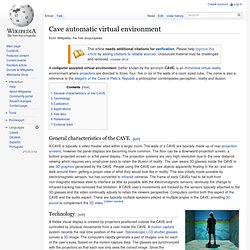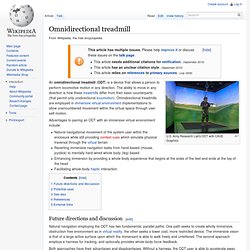

Cave automatic virtual environment. General characteristics of the CAVE[edit] A CAVE is typically a video theater sited within a larger room.

The walls of a CAVE are typically made up of rear-projection screens, however flat panel displays are becoming more common. The floor can be a downward-projection screen, a bottom projected screen or a flat panel display. The projection systems are very high-resolution due to the near distance viewing which requires very small pixel sizes to retain the illusion of reality. Omnidirectional treadmill. U.S.

Army Research Lab's ODT with CAVE Graphics Advantages to pairing an ODT with an immersive virtual environment include: Natural navigational movement of the system user within the enclosure while still providing context cues which simulate physical traversal through the virtual terrainReverting immersive navigation tasks from hand-based (mouse, joystick) to mentally hard-wired whole body (leg) basedEnhancing immersion by providing a whole-body experience that begins at the soles of the feet and ends at the top of the headFacilitating whole-body haptic interaction Future directions and discussion[edit] Natural navigation employing the ODT has two fundamental, parallel paths. AlloSphere. The AlloSphere is a research facility in a theatre-like pavilion in a spherical shape, of opaque material, used to project computer-generated imagery and sounds.

Included are GIS, scientific, artistic, and other information. Located at the University of California, Santa Barbara (UCSB) the AlloSphere grew out of the schools of electrical engineering and computer science, and the Media Arts & Technology program at UCSB. The AlloSphere is housed at UCSB California Nanosystems Institute building, "CNSI," or Elings Hall, a 62,000-square-foot (5,800 m2) facility that opened in 2007.